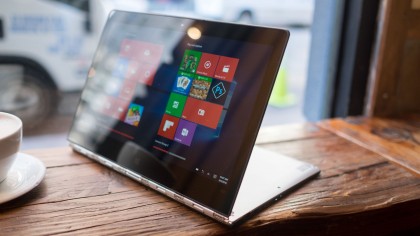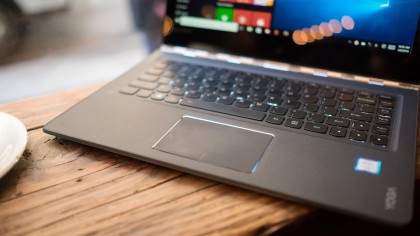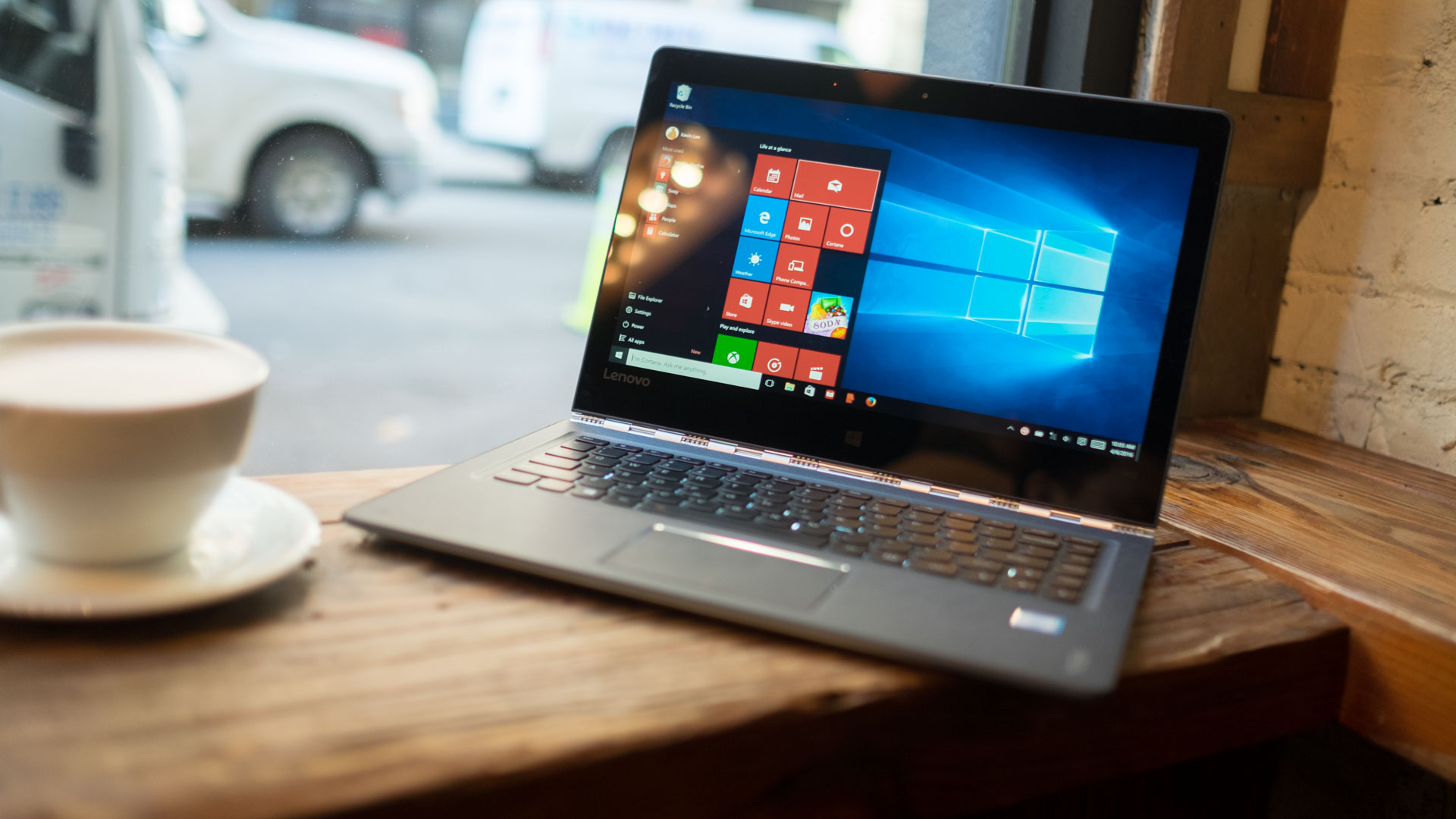TechRadar Verdict
Lenovo addressed complaints people had with the Yoga 3 Pro by adding a bigger battery, more powerful processor and improved keyboard and trackpad to make the Yoga 900 the best Yoga it has built to date. Even though this may feel like an iterative release, these tweaks add up to make the Yoga 900 a balanced, thoughtfully designed and refined 2-in-1 convertible.
Pros
- +
Intel Skylake processor
- +
Gorgeous display
- +
Slim design
Cons
- -
Shallow keyboard
- -
Issues with display drivers
- -
No pen input
Why you can trust TechRadar
After launching the Yoga 3 Pro last year, Lenovo found a winning design formula, and it isn't deviating much with this year's refresh.. The Yoga 900 has a different numbering convention, but the convertible Ultrabook is an iterative successor to the Yoga 3 Pro, promising longer battery life, faster performance and improvements to a winning 360-degree swiveling hinge design.
Sporting Intel's sixth generation Skylake processor, the Yoga 900 ($1,199, £797, AU$1,705) comes with the same processing power as Microsoft's Surface Pro 4 ($999, £664, AU$1,420) and Surface Book ($1,499, £996, AU$2,131). All three devices utilize a convertible design, but instead of detachable displays like on the Surface line, Lenovo opted for a rotating hinge with the Yoga 900.
With a screen that rotates 360 degrees, the Yoga 900 competes most closely against the HP Spectre x360 ($1,099, £730, AU$1,563) and the 4K-equipped Toshiba Satellite Radius 12 ($1,299, £848, AU$1,773).

Design
Clad in a silver metal shell, you'd be forgiven if you mistook the Yoga 900 for yet another MacBook Pro clone. But that's where the similarities end, and this immediately becomes apparent when you take a look at the rear of the Yoga 900 and notice the unique hinge.
Lenovo debuted its watchband hinge on last year's Yoga 3 Pro as a way to completely rotate the screen 360 degrees and convert the laptop to a tablet form factor. This year, the hinge has been improved. Constructed of 813 pieces of steel, the hinge also conceals a rear-facing vent, allowing hot air to escape out the back instead of down your lap.
Unlike the Yoga 3 Pro's power-sipping Core M processor, the more powerful Intel Core i series CPU requires active cooling. Internally, heat management is also controlled by a new metal alloy fan design, which Lenovo claims is 66% more efficient and 30% better at cooling than its predecessors.
Coupled with the silver metal lid and metal bottom plate, the watchband hinge gives the laptop a premium feel. Lenovo also offers the Yoga 900 in clementine orange, platinum silver and champagne gold.
Sign up to the TechRadar Pro newsletter to get all the top news, opinion, features and guidance your business needs to succeed!

For most users, the notebook feels balanced when you use it, but keen designers will notice that the laptop's weight isn't as balanced as on the MacBook Pro. Apple has perfected the weight distribution of its laptop so that users can lift open the lid with one hand without the base sliding or slipping on a tabletop. This isn't the case with the Yoga, but you can always overcome this issue when you open the laptop with two hands.
At 2.84 pounds (1.29kg), the Yoga 900 feels light for an Ultrabook, but you likely wouldn't want to hold it as a tablet for too long. When used for long durations, the Yoga will feel heavy since you can't separate the keyboard and the screen, unlike the 2.3-pound (1.05kg) Surface Pro 4 and 3.48-pound (1.58kg) Surface Book. With just the screen, the Surface Pro 4 weighs 1.69 pounds (766g) and the Surface Book comes in at 1.6 pounds (725g).
As a convertible, the Yoga 900 is lighter than the 3.35-pound Dell XPS 12, 3.96-pound Asus Transformer Book TP300LA and the 3.26-pound Spectre x360. It's also thinner than these devices, measuring 12.75 x 8.86 x 0.59 inches (324 x 225 x 14.9mm). The Transformer Book measures 12.9 x 8.86 x 0.86 inches (329 x 225 x 22mm), while the Spectre measures 12.79 x 8.6 x 0.63 inches (325 x 218 x 16mm).
Considering the power under the hood and that the keyboard can't be removed, the Yoga 900 feels extremely slim and compact. The 0.59-inch thickness places the Yoga 900 within close range of Microsoft's impressively slim Surface Pro 4's dimensions. The Surface Pro 4 with Type Cover measures 11.60 x 8.50 x 0.52 inches (295 x 216 x 13.2mm), but Microsoft's tablet comes with a smaller 12.3-inch display.

The 13.3-inch QHD+ resolution (3,200 X 1,800 pixels) isn't as high as the 4K UHD screens on Samsung's ATIV Book 9 or Toshiba's Satellite Radius 12, but the Yoga still displays text and images crisply. The resolution is similar to the 13.5-inch Surface Book's 3,000 x 2,000 display, the difference is that the Yoga has a 16:9 aspect ratio whereas the Surface Book has a 3:2 screen.
I found the Yoga's aspect ratio to be better suited for watching videos, as 16:9 HD movies will display without any letterboxing, but the screen can feel a bit narrow for productivity. The 3:2 Surface Book display allows you to see more content without having to scroll vertically, and when used in tablet mode, the 3:2 aspect ratio feels more natural. In this orientation, the 16:9 aspect ratio makes the Yoga feel a bit top-heavy because of its longer size.
The Yoga 900 displayed colors vibrantly, and its blacks are deep. However, on our review unit, I did notice a little bit of backlight leaking around the edges near the corners of the display. The screen around this area would be more brightly lit than the rest of the display, which could have an impact for business users looking to do light graphics or editing work requiring a more accurate display.
Lenovo also fixed the flexing complaint on the Yoga 3 Pro. On the Yoga 900, when grabbing the laptop by the corners of the screen, I notice a little bit of flexing, but the screen panel didn't display any rippling or discoloring effects.

To play up the premium aspect of the notebook, Lenovo opted to outfit the keyboard deck with a textured faux leather material. The leather is smooth, compared to the perforated leather-like material on last year's model.
I'm torn on the use of leather. On one hand, the material feels slightly rubbery and not as luxurious as Lenovo would like you to believe, but it feels nicer than a soft-touch coat of paint. And compared to metal, like on the MacBook, the material is nice as it's not cold when you rest your wrist while typing.
In addition to the luxury angle, the simulated leather also has a utilitarian purpose. When you're using the Yoga 900 in display mode, which means the keyboard is placed face down on a tablet top and the screen facing you like an easel, the leather material provides grip and helps prevent the Yoga 900 from skidding across the table.
The bottom of the device is clean, except for two Dolby-tuned stereo JBL speakers. Lenovo kept the undercarriage of the laptop vent-free, which seems like a smart decision since the vents would be blocked if the device is used as a tablet.

Keyboard and trackpad
The Yoga 900 comes with a full-sized backlit keyboard. Each key comes with Lenovo's trademarked U-shaped design, which the company claims to be more forgiving to typists who may not hit the exact center of each key cap.
As the Yoga is a consumer device, unlike Lenovo's ThinkPad series, key travel is a bit more shallow and the key caps are flat and not curved.
I found the keyboard design and layout to be comfortable and accurate. Unlike on smaller devices, the full-sized keyboard offered standard key spacing, so typing required no adjustment. However, it did take some time to adjust to the shallow key travel, but the keys are responsive, springy and not too stiff.
Just below the keyboard is the buttonless trackpad, which offers a large, smooth glass area for interacting with Windows 10. I found tracking to be responsive. But despite the premium feel of the glass, the trackpad initially felt mushy, like it was sticking to something underneath when you pressed down on it to make a right- or left-click. The mushiness improved over time, but the trackpad rattles and moves around a bit when you're running your fingers lightly across it. This doesn't affect performance, but was generally annoying.

When you're using the Yoga 900 in tablet mode, the keyboard and trackpad orient towards the rear of the device, and your fingers will grip onto the keys as you're holding the slate. Even though you may be pressing on the keyboard with your fingers, the keyboard's functionality is locked on the software side so you won't be accidentally be typing errant letters or activating the trackpad unintentionally.
